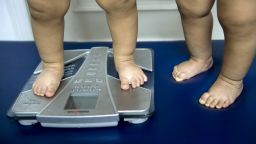The treatment and prevention of childhood obesity starts at home

By: Dr. Samir Softic and Dr. Aurelia Radulescu
University of Kentucky
In the United States, one in five children are obese. (In Kentucky, that rate is closer to one in four.)
Obesity is a chronic disease with many contributing factors, including family history, access to healthy foods, hormonal and metabolic conditions and even environmental factors such as how “walkable” neighborhoods and cities are. All of these things can have a negative impact on a child’s weight.
Obesity in children can lead to other health conditions, such as diabetes, high blood pressure, lipid abnormalities, sleep disorders, as well as depression, anxiety and behavioral issues.
Children learn from their parents; the lifestyle choices modeled for them inform the patterns and habits they have as adults. Further, poor eating and exercise habits established in childhood can be difficult to modify later in life.
To help give your child the best chance of growing into a healthy adult, parents and caregivers need to lead by example and help their children build a lifetime of healthy habits.
Treating and preventing obesity in children starts at home. Here are some ways to get the whole family to make positive, sustainable changes together:
- Consider your language: Using words like “fat” and “chubby,” commenting on a child’s body size and policing eating habits can be very damaging to a child who may already be self-conscious about their body. Support and empathy are essential first steps in obesity treatment.
- Involve the whole family: Even if parents, caregivers and other family members aren’t obese, make a plan that incorporates the entire family so that the child doesn’t feel singled out or isolated for their obesity treatment. New healthy habits will be beneficial for everyone.
- Start with small changes: Don’t restrict your and your child’s thinking to “diet” and “exercise.” Instead, focus on building small, sustainable habits that involve the whole family, such as going for a walk after dinner, having an extra serving of fruit and vegetables and substituting sugar-free juice or lemonade for soda.
- Make it fun: Try something new as a family, such as exploring Kentucky’s state parks or participating in a community fun run. Pickleball, nature walks and neighborhood scavenger hunts are just a few more examples of how you can make movement fun. Cooking together at home is another way to have fun and eat a nutritious meal.
- Get professional help: In addition to advice from your child’s pediatrician, seek guidance from pediatric obesity specialists and nutritionists to help guide and monitor obesity treatment.
(Editor’s note: In June, Dr. Steven Stack, commissioner of the Kentucky Department for Public Health, told MD-Update in an interview that in 2021-2022, the most recent data available, 24.6% of Kentucky children between the ages of 0 and 17 years old were obese, the second highest rate of childhood obesity in the nation.)
Dr. Samir Softic is the medical director of UK HealthCare’s Pediatric Fatty Liver Clinic and Dr. Aurelia Radulescu is the medical director of the Pediatric BMI Clinic at Kentucky Children’s Hospital.